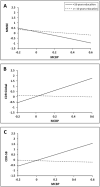Cognitive reserve and β-amyloid pathology in Parkinson disease
- PMID: 26037458
- PMCID: PMC4509801
- DOI: 10.1016/j.parkreldis.2015.05.020
Cognitive reserve and β-amyloid pathology in Parkinson disease
Abstract
Introduction: Dementia in Parkinson disease (PD) is associated with abnormal accumulation of proteins, including β-amyloid, in cortical regions. High cognitive reserve capacity may protect cognition from β-amyloid and delay the onset of dementia. We tested the cognitive reserve theory in PD by determining whether educational attainment, a proxy for cognitive reserve, modifies the correlation between cortical β-amyloid accumulation and cognitive impairment.
Methods: PD participants (N = 155) underwent MRI to quantify brain volume and [(11)C] PiB PET imaging to quantify fibrillar β-amyloid deposition. Mean cortical binding potentials (MCBP) were calculated for each participant, with higher scores indicating more fibrillar β-amyloid. Global cognitive function was assessed using the Clinical Dementia Rating (CDR) and Mini-Mental State Examination (MMSE). Multiple linear regression analysis was used to determine whether education modified the relationship between MCBP and cognitive function after controlling for brain volume.
Results: MCBP interacted with educational attainment to predict scores on each of the cognitive outcome measures (ps ≤ 0.02). Post-hoc analysis revealed that the effect of MCBP on cognitive function changed once the level of education reached 16 years. For participants with less than 16 years of education (n = 68), higher MCBP correlated with worse cognitive function, with MCBP accounting for 8-30% of the variance in MMSE and CDR scores (ps ≤ 0.02). For participants with at least 16 years of education (n = 87), MCBP did not correlate with MMSE or CDR scores (R(2)s < 0.02, ps ≥ 0.17).
Conclusion: These findings provide support for the cognitive reserve theory in PD and suggest that education may protect PD patients' cognition against cortical β-amyloid pathology.
Keywords: Cognition; Cognitive reserve; Dementia; Education; Parkinson's disease.
Copyright © 2015 Elsevier Ltd. All rights reserved.
Conflict of interest statement
The authors declare no conflicts of interest.
Figures
References
-
- Aarsland D, Zaccai J, Brayne C. A systematic review of prevalence studies of dementia in Parkinson's disease. Mov Disord. 2005 Oct;20(10):1255–63. - PubMed
-
- Hely MA, Reid WG, Adena MA, Halliday GM, Morris JG. The Sydney multicenter study of Parkinson's disease: the inevitability of dementia at 20 years. Mov Disord. 2008 Apr 30;23(6):837–44. - PubMed
-
- Aarsland D, Perry R, Brown A, Larsen JP, Ballard C. Neuropathology of dementia in Parkinson's disease: a prospective, community-based study. Ann Neurol. 2005 Nov;58(5):773–6. - PubMed
Publication types
MeSH terms
Substances
Grants and funding
LinkOut - more resources
Full Text Sources
Other Literature Sources
Medical


